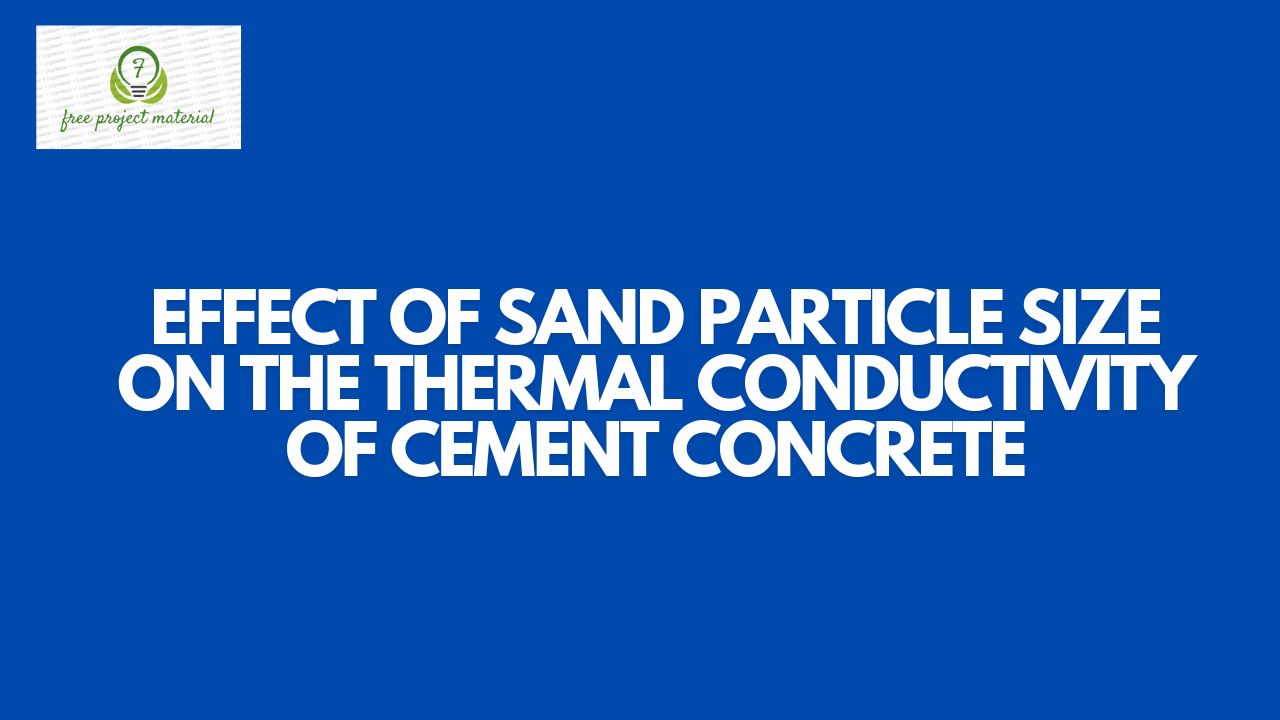ABSTRACT
The effect of sand particles size on the thermal conductivity of concrete was investigated. Cement concrete was made sing sand particles of sizes 3.5×10-4m, 2.6×10-4m, 2.5×10-4m and 1.9×10-4m by radius as the aggregate. Thermal conductivity of the cement concrete was determined using the Lee’s disc apparatus method. The result showed that sample A with radius 3.5×10-4m had the highest thermal conductivity value of 166.46W/mK followed by that of sample B with sand particle radius 2.6×10-4m with the thermal conductivity value of 163.95W/mK then sample C with sand particle of radius 2.5×10-4 had a thermal conductivity value of 141.59W/mK while sample D with sand particle of radius 1.9×10
TABLE OF CONTENTS
Title Page
Certification
Dedication
Acknowledgements
Abstract
Table of Contents
CHAPTER ONE
1.0 Introduction
1.1 Background of the Study
1.2 Aims and Objectives of the Study
1.3 Scope and Limitations of the Study
CHAPTER TWO
2.0 Literature Review
2.1 The concept of heat energy
2.2 Specific heat capacity
2.3 Factors affecting conductivity of a material
2.3.1 Temperature difference
2.3.2 Thickness of the materials
2.3.3 Cross section area
2.4 Cement concrete
CHAPTER THREE
3.0 Materials and Methods
3.1 Sample Collection and Precaution
3.2 Theory
CHAPTER FOUR
4.0 Results and Discussion
4.1 Results
4.2 Discussion
CHAPTER FIVE
5.0 Conclusion and Recommendation
5.1 Conclusion
5.2 Recommendation
References
CHAPTER ONE: INTRODUCTION
1.1 Background of the Study
Energy conservation is required on account of the growing population and limited natural energy sources. One third of the total energy consumption and 30% of greenhouse gas emissions are attributed to building in most countries (Zhang et al., 2004; Martinez-Molina et al., 2016). Since most people spend around 90% of their lives indoors energy conservation and thermal comfort in buildings are controversial topics (De Giuli and Da Pos, 2012). The energy required for building’s cooling and heating and thermal comfort depend greatly on the thermo-physical properties of the construction materials.
Ventilation and fabrics heat loss are two reasons for heat loss in building. Ventilation heat loss entails convective heat transfer through air replacement by heating, ventilation and air conditioning systems. However, fabric heat loss is related to conductive heat loss through walls, roof, windows and floors (Latha et al., 2015).
Heat transfer is the movement of heat from one place to another and it occurs through conduction, convection and radiation (Incropera and Dewitt, 1985). Conductive heat transfer in solids is a mixture of molecular vibration and energy transport by free electrons. Thermal conductivity (K-values is a materials property that demonstrates its heat conduction capability. The energy consumption of building is dependent on the thermal conductivity values of the building materials. Materials with low and moderate thermal conductivity such as mineral wool (0.03-0.04 W/m.oK)< cellulose insulation (0.04-0.05 W/m. oK) Cork (0.04-0.05 W/m oK), expanded polystyrene (EPS) (0.03-0.04 W/m. oK), polyether (0.02-0.03 W/m.oK) and cecemic tiles (1.10 W/m.oK) can reduce the energy usage in buildings (Jelle, 2011; Barreira and de Freitas, 2007).
The thermal conductivity of a material or element is a defining property that aids in the development of effective heating/cooling technologies. A value for thermal conductivity can be determined by measuring the rate at which heat can pass through materials.
This value is expressed in watts per meter, per degree kelvin W/m.oK. Materials with a high thermal conductivity can effectively transfer heat by conduction while materials with lower thermal conductivity do not readily transfer heat and are slow to take up heat from their surrounding, one of the factors that affect thermal conductivity of a composite in the type of admixture. This research project seeks to investigate the size of sand particle (aggregate) on the thermal conductivity of cement concrete.
1.2 Aims and Objectives of the Study
Aims:
The aim of the study is to determine the effect of sand particle size on the thermal conductivity of cement concrete.
The Objectives of the Studies are:
- To determine thermal conductivity of cement concrete concentration
- To determine effect of sand particle sizes on the thermal conductivity of cement concrete.
- To make useful recommendation base on the result of this study
1.3 Scope and Limitations of the Study
This study will only cover the effect of sand particle size on the thermal conductivity of cement concrete. Lee’s disc apparatus shall be used to determine thermal conductivity of the concrete samples.


